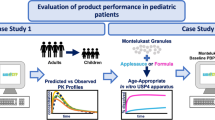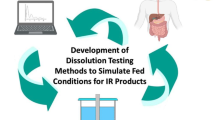Abstract
Predictive in vitro test methods addressing the parameters relevant to drug release in the pediatric gastrointestinal tract could be an appropriate means for reducing the number of in vivo studies in children. However, dissolution models addressing the particular features of pediatric gastrointestinal physiology and typical pediatric dosing scenarios have not yet been described. The objective of the present study was to combine the knowledge on common vehicle types and properties and current information on pediatric gastrointestinal physiology to design a dissolution model that enables a biorelevant simulation of the gastrointestinal conditions in young children. The novel dissolution setup consists of a miniaturized dissolution system allowing the use of small fluid volumes, physiological bicarbonate-based test media, and a proper pH control during the experiment using a pHysio-stat® device. Following design and assembly of the novel in vitro setup, a set of experiments screening in vitro drug release from a valproate-extended release formulation under typical dosing conditions in infants was performed. In vitro drug release profiles indicated a controlled drug release of the test product over 12 h and were in good agreement with information given in the Summary of Product Characteristics and the Patient Information Leaflet, as well as with results from an in vivo food effect study performed with the same product and reported in the literature. The new dissolution setup thus represents a promising in vitro screening tool in the development of pediatric dosage forms and may help to reduce the number of pharmacokinetic studies in children.






Similar content being viewed by others

References
Ivanovska V, Rademaker CMA, van Dijk L, Mantel-Teeuwisse AK. Pediatric drug formulations: a review of challenges and progress. Pediatrics. 2014;134(2):361–72.
Nunn T, Williams J. Formulation of medicines for children. Br J Clin Pharmacol. 2005;59(6):674–6.
Batchelor HK, Fotaki N, Klein S. Paediatric oral biopharmaceutics: key considerations and current challenges. Adv Drug Deliv Rev. 2014;73:102–26.
Guideline on pharmaceutical development of medicines for paediatric use. In: (CHMP) CfMPfHU, (PDCO) PC, London: European Medicines Agency; 2013.
van Riet-Nales DA, Wang S, Saint-Raymond A, Robert JL. The EMA quality guideline on the pharmaceutical development of medicines for paediatric use. Int J Pharm. 2012;435(2):132–4.
Garbacz G, Kolodziej B, Koziolek M, Weitschies W, Klein S. An automated system for monitoring and regulating the pH of bicarbonate buffers. AAPS PharmSciTech. 2013;14(2):517–22.
Garbacz G, Kolodziej B, Koziolek M, Weitschies W, Klein S. A dynamic system for the simulation of fasting luminal pH-gradients using hydrogen carbonate buffers for dissolution testing of ionisable compounds. Eur J Pharm Sci. 2014;51:224–31.
Kersten E, Barry A, Klein S. Physicochemical characterisation of fluids and soft foods frequently mixed with oral drug formulations prior to administration to children. Pharmazie. 2016;71(3):122–7.
Klein S. The mini paddle apparatus—a useful tool in the early developmental stage? Experiences with immediate release dosage forms. Dissolut Technol. 2006;13(4):6–11.
Klein S, Shah VP. A standardized mini paddle apparatus as an alternative to the standard paddle. AAPS PharmSciTech. 2008;9(4):1179–84.
Orfiril® long Fachinformation (summary of product characteristics). Rote Liste Service GmbH; 2015.
Lopez FL, Ernest TB, Tuleu C, Gul MO. Formulation approaches to pediatric oral drug delivery: benefits and limitations of current platforms. Expert Opin Drug Deliv. 2015;12(11):1727–40.
Klingmann V, Spomer N, Lerch C, Stoltenberg I, Fromke C, Bosse HM, et al. Favorable acceptance of mini-tablets compared with syrup: a randomized controlled trial in infants and preschool children. J Pediatr. 2013;163(6):1728–32.
Klingmann V, Seitz A, Meissner T, Breitkreutz J, Moeltner A, Bosse HM. Acceptability of uncoated mini-tablets in neonates—a randomized controlled trial. J Pediatr. 2015;167(4):893–6.
Nagita A, Amemoto K, Yoden A, Aoki S, Sakaguchi M, Ashida K, et al. Diurnal variation in intragastric pH in children with and without peptic ulcers. Pediatr Res. 1996;40(4):528–32.
Miller BR, Tharp JA, Issacs WB. Gastric residual volume in infants and children following a 3-hour fast. J Clin Anesth. 1990;2(5):301–5.
Cook-Sather SD, Harris KA, Chiavacci R, Gallagher PR, Schreiner MS. A liberalized fasting guideline for formula-fed infants does not increase average gastric fluid volume before elective surgery. Anesth Analg. 2003;96(4):965–9.
Litman RS, Wu CL, Quinlivan JK. Gastric volume and pH in infants fed clear liquids and breast milk prior to surgery. Anesth Analg. 1994;79(3):482–5.
Wells KA, Losin WG. In vitro stability, potency, and dissolution of duloxetine enteric-coated pellets after exposure to applesauce, apple juice, and chocolate pudding. Clin Ther. 2008;30(7):1300–8.
Retzow A, Vens-Cappell B, Wangemann M. Influence of food on the pharmacokinetics of a new multiple unit sustained release sodium valproate formulation. Arzneimittelforschung. 1997;47(12):1347–50.
Sweetman SC. Martindale—the complete drug reference. 33rd ed. London: Pharmaceutical Press; 2002.
Acknowledgements
This work was funded by the German Ministry of Economics and Technology (AZ V-630-F-157-2012/230). The authors would like to thank the staff of the precision mechanics workshop of the Faculty of Mathematics and Natural Sciences at the University of Greifswald for their support in manufacturing the parts and assembling the novel apparatus. Parts of this work were presented at the 10th World Meeting on Pharmaceutics, Biopharmaceutics and Pharmaceutical Technology, April 2016, Glasgow, UK, and the 8th Conference of the European Paediatric Formulation Initiative (EuPFI), September 2016, Lisbon, Portugal, and received a poster award from the Professional Compounding Centers of America (PCCA) at the 2016 EuPFI conference.
Author information
Authors and Affiliations
Corresponding author
Additional information
Guest Editors: Maren Preis and Jörg Breitkreutz
Rights and permissions
About this article
Cite this article
Karkossa, F., Krueger, A., Urbaniak, J. et al. Simulating Different Dosing Scenarios for a Child-Appropriate Valproate ER Formulation in a New Pediatric Two-Stage Dissolution Model. AAPS PharmSciTech 18, 309–316 (2017). https://doi.org/10.1208/s12249-016-0671-3
Received:
Accepted:
Published:
Issue Date:
DOI: https://doi.org/10.1208/s12249-016-0671-3



